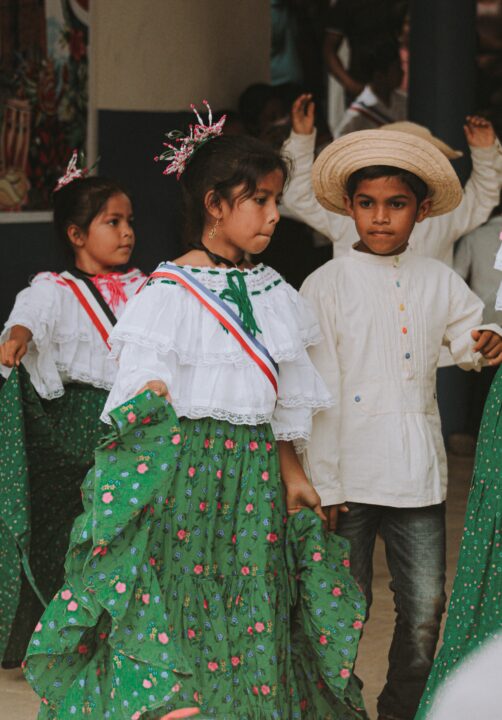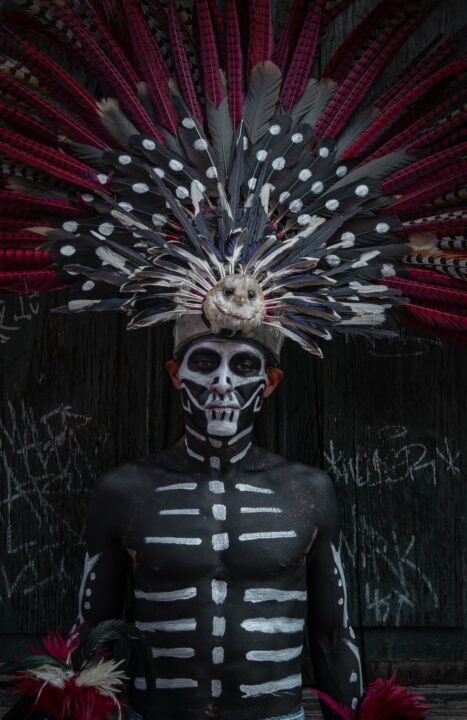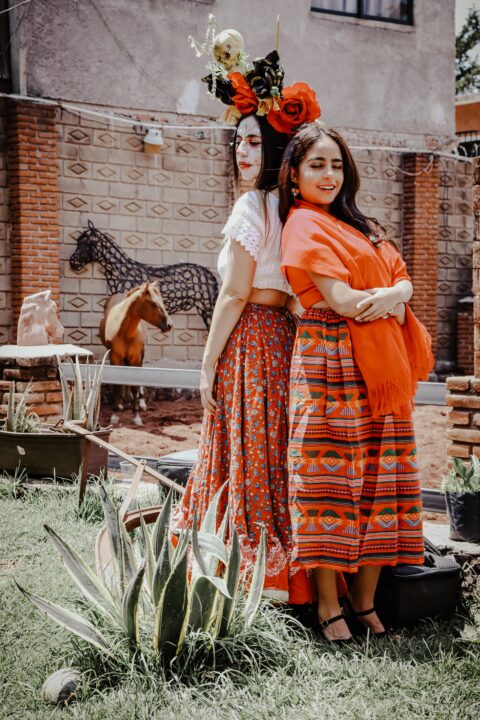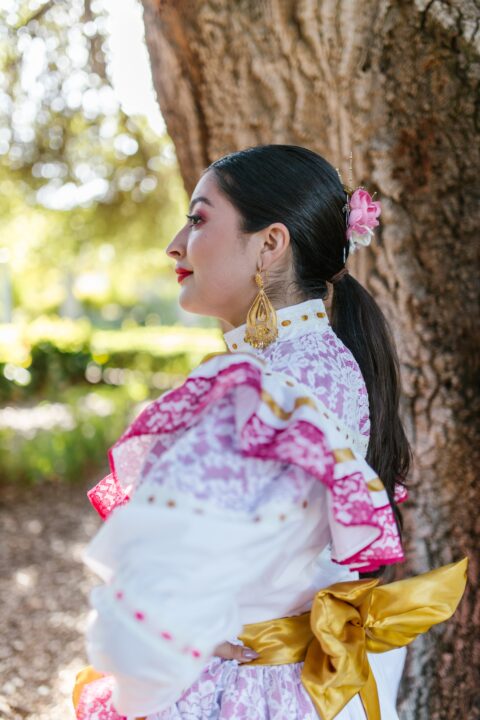Puerto Rico is a beautiful country and self-governed, unincorporated territory on the Caribbean Island, surrounded by blue skies and a landscape of scenic mountains.
Puerto Rico was formerly called the island of Borinquen and was occupied by indigenous people called the Tainos until the arrival of Christopher Columbus, which led to the island being colonized by Spain at the end of the 15th century.
When Columbus arrived with the Spanish on the island, they were surprised to see how little the indigenous Taino people wore because of their hot climate. Most of them were completely naked, while their married women were expected to cover themselves with a simple skirt or apron.
Prior to the arrival of the Europeans, the indigenous Taino people had their own unique traditional clothing. Their clothing was mostly influenced by their culture and the climate of the island; it also had a distinct symbolism, like their jewelry, body paint and garments, which could depict a person’s social and religious standing in society.
As the Spanish took over and began mixing with the natives, they also had to adopt Spanish styles in their dressing. The Spaniards wore full length uniforms after arriving on the island despite the extreme heat and humidity, therefore, the natives could not understand the European style of clothing with its heavy, layered materials, it made no sense to them because their climate was hot.
Following the slave trade era, Puerto Rico’s style became greatly influenced by Africans who were forcefully brought over to work on their plantations. In fact, the culture of Puerto Rico, including their dressing, is a result of the blend of different cultures, both international and indigenous.
By the late 19th century, a prominent Puerto Rican identity began to form with a fusion of Spanish, African, and native Taino concepts. So, Puerto Rico’s culture and clothing are a beautiful and colorful mixture of old and new, indigenous, Spanish, and African traditions.
Since the arrival of the Europeans, Puerto Rico’s dressing style has changed greatly but let’s take you back to the traditional and historical clothing of the indigenous Taino people.
1. Traditional men’s clothing in Taino culture
-

juliet montesinos, pexels, 13371345.jpg
Because of the island’s heat and humidity, Taíno men simply went without clothing. However, they used paints to decorate their bodies and wore jewelry (including necklaces, bracelets, and earrings) made from bones, rocks, feathers and corals. These decorations were common and often bore meaning related to religious status or social rank.
2. Traditional women’s clothing in Taino culture
-

erika reyes, pexels, 13649113.jpg
While their men typically wore no clothing, women started wearing skirts or aprons called “naguas” when they reached adolescence or got married. The length of women’s naguas was determined by social status. Women with higher social status wore full-length skirts, while lower-class women wore shorter skirts. Women also wore body paint and jewelry (including necklaces, bracelets, and earrings) made from bones, rocks, feathers and corals in similar fashion to men. They also wore their hair long.
Despite the trends that brought about the current traditional Puerto Rican clothing, which is mostly characterized by vibrant colors, bright whites and flare skirts, there are three distinct styles of Puerto Ricans. The Jibaro culture, Bomba culture and Plena culture. These cultures reflect the original native traditions as well as influences from outside.
3. Traditional Clothes in the Jíbaro Culture
The Jíbaro culture is the dominant culture in Puerto Rico and the term Jibaro is used to refer to the countryside people or farmers who cultivate the land in a traditional way. The traditional Jíbaro people were self-subsistence farmers, and salesmen who grew enough crops to sell in the towns near their farms to be able to purchase the simple necessities for their families.
The Puerto Ricans are very proud of their Jíbaro heritage because subsistence farming was an iconic reflection of the Puerto Rican people and culture. Jíbaro culture was heavily influenced by the Spanish arrivals and as a result, had a great influence on their clothing styles too. It all formed a new culture that blended native traditions with Spanish influences.
For the clothing most especially, Jíbaro fashion came to strongly resemble the famous Spanish flare with its brilliant colors, flowing fabrics, and flowers, which depicted celebration.
According to Jose A. Mari Mut, an academician and professor at the University of Puerto Rico, the traditional clothing of jíbaro men consisted of a long-sleeved white shirt and white pants, a fringe-less hat, and no shoes. Their cotton shirts and pants were simple and their straw hats completed the look. Some men also wear a colorful sash around their waist. Whenever Jíbaro fashion is used for performances, the apparel often includes a matching neck kerchief.
Women’s traditional fashion seemed to be more colorful than men’s fashion in Jíbaro culture. It consists of vibrant and multicolored, flowing skirts worn with low cut white blouses, which often leave the shoulders and neck exposed. The jíbaro woman called jíbara would also usually dress in white with a long shirt, shoulders and neck often covered, they would sometimes wear a hat or a bandana as a hair cover.
4. La mapola (flower for the hair)
-

rdne stock project, pexels, 8639067.jpg
Jíbaro women did not joke with their flowers. They often decorated their hair with flowers.
5. Jewelry
They thrive on large pieces of jewelry made from different materials like bones, rocks, feathers and corals. Their hoop earrings added the final touch to their outfit. Like men, women also went without shoes, but they sometimes wear sandals and a machete. The most prominent part of the Jíbaro dressing is their headdresses, which are straw hats for men and flower bonnets for women.
Contrary to the notion that Jíbaro people wore little to no clothing and shoes due to not having enough to provide these basic needs for their people, the custom of not wearing shoes was not associated with poverty, instead, it was attributed to having comfort and being convenient in their homeland.
6. Traditional clothing in the bomba culture
Bomba is a Puerto Rican traditional dance and musical genre whose origins date back to the beginning of the Spanish colonial period (1493–1898) on the plantations where the West African enslaved people and their descendants worked in sugar plantations along the coast of Puerto Rico.
The genre has evolved today into a rich cultural and communal expression of Puerto Rican culture and traditions. It is still one of the most popular forms of folk music on the island and readily serves as significant evidence of its rich African heritage, distinct from its own dressing and expressions.
The traditional costumes of the bomber culture of Puerto Rico are similar to the traditional slave attire. In full contrast to Jíbaro clothing, which had a distinctive Spanish flare, Bomba clothing tended to be a bit less glaring in nature. Though white was the dominant color, brighter colors were used as accents or complements.
In Bomba, traditions, men often wore a colored shirt tied at the waist and pants cut at the ankles, or they dressed elegantly in a full white suit. Men could also be seen wearing a straw or white Panama hat.
Women Bomba clothing contrasted greatly with the brightly colored Jíbaro dresses and skirts. Bomba skirts were often white with colorful accents, usually blue and red. Women also wore petticoats and short blouses to add a fashionable silhouette to their dresses. They usually wore a turban or left their hair flowing without adornment, unlike the Jíbaro women.
7. Traditional Clothes in the Plena Culture
Plena is a genre of music and dance in Puerto Rico, originating in Joja del Castillo Ponce around 1900. It blends Latin American and African musical traditions into a uniquely Puerto Rican style. Plena was firstly accepted by working-class people in Puerto Rico and gradually became a unique symbol of Puerto Rican culture with the influences of Jíbaro, native Taino, and European cultures.
The Plena traditional clothing for women is colorful short dresses above their knees. They, like the Jíbaro women, wear flowers in their hair. The men wear Pavas or Panama hats which are both varieties of straw hats, with Guayabera shirts, which are often white.
The Guayabera is a traditional men’s shirt and the most distinctive and well-known garment from Puerto Rico. It is a well-tailored shirt for men that has patch pockets on the front and is often worn over an undershirt or vest. These buttoned shirts are tailored to fit but are loose fitting with short slits on each side, and a few buttons are left open so that the undershirt shows from underneath it.
Materials used to make the Guayabera are locally sourced and include cotton and linen, although the traditional version of the Guayabera shirt, the one usually used as formal wear, is made from the pineapple plant.
In conclusion, the Puerto Rican tradition is multicolour and beautiful. The good people of this small Caribbean Island wear a variety of traditional dresses, which describes their multiple heritages. The traditional clothing of Puerto Rico is a beautiful and amazing blend of Jíbaro, Bomba and Plena cultures.






